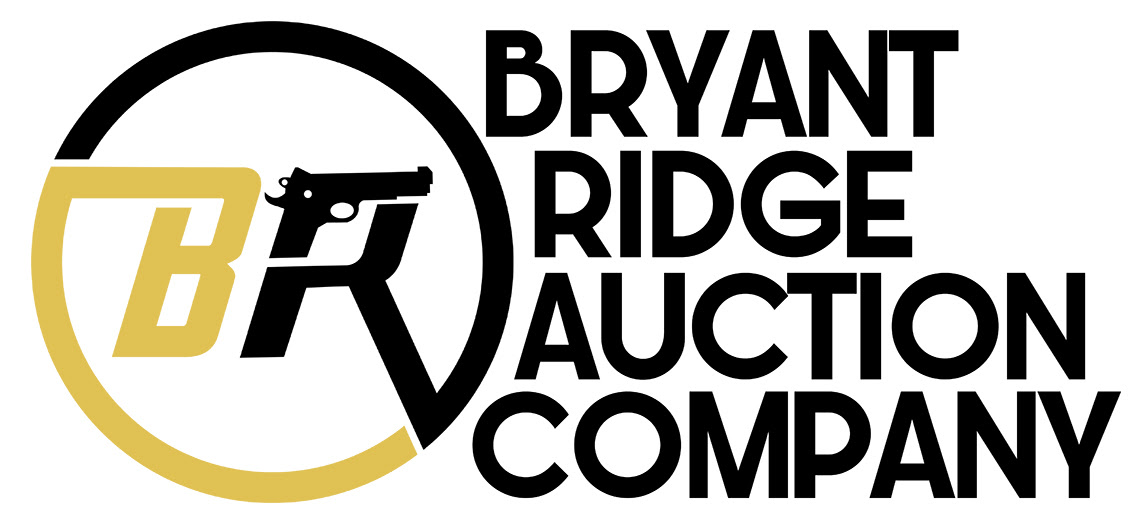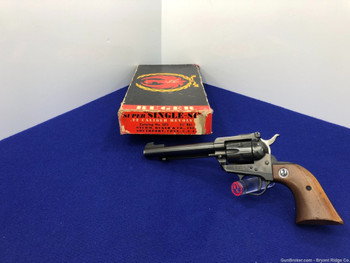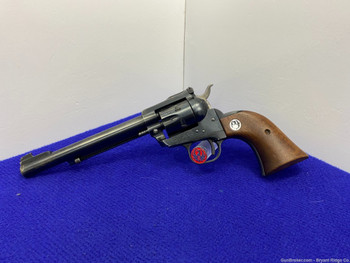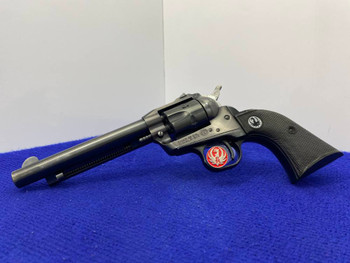Description

Item Description
Bryant Ridge Auction Company is pleased to present this single-action rimfire revolver today for a penny-start auction; this is the Ruger Single-Six!
This particular variant is a highly sought-after unconverted three-screw model!
This particular variant is a highly sought-after unconverted three-screw model!
Manufacturer: Ruger
Model: Single-Six
Serial: 100822
Date of Manufacture: 1958
Caliber: .22 Long Rifle
Finish: Blue
Barrel Length: 5.5"
Optics/Sights: Fixed Front with Dovetail Square Notched Rear
Stock/Grips: Smooth Walnut with Silver/Black Ruger Medallions
Action: Single-Action
Markings: Standard
Bryant Ridge's Analysis:
In the late 1940s, the United States, freshly recovered from World War Two, had a renewed and insatiable love affair with the "old West." The movies featured "Westerns" with John Wayne, Gary Cooper, Roy Rogers, William Boyd, Gene Autry, and many others in roles that glorified the days of the Western frontier. The heroes wielded Colt single-action revolvers in nearly all these movies and similar portrayals on TV. The public loved those cowboy sagas and those old cowboy guns. But strangely, in 1947, Colt's Patent Firearms Manufacturing Company announced that it would not resume manufacturing its classic Single Action Army revolver. The machinery to make it had been dismantled and scrapped as Colt attended to manufacturing other guns during WWII. Bill Ruger, president and CEO of the fledgling Sturm, Ruger & Company, saw this as an opportunity to step in and provide folks with the ability to purchase a Single Action Army look-alike revolver at a great price. It could be chambered for the economical .22 Long Rifle cartridge.
Ruger broached the subject of a Colt look-alike .22 revolver with his patent attorneys, and they agreed that Colt no longer had patent rights on their classic single action. Thus, Ruger had the green light to develop a similar revolver. The nickname of the SAA was the "Peacemaker," and it was realized that name was pretty much off-limits. The name "Single Six" was chosen, and the resulting new gun accelerated the expansion of the Ruger firm.
While working as an engineer at the Auto-Ordnance company, Bill Ruger was introduced to investment casting, essentially a modern application of the ancient "lost wax" process used in jewelry making and dental work. He initially worked with a jewelry company called Arwood, located in Brooklyn, NY, to adapt that process to make the trigger and the hammer of the Single Six. At first, that company told Ruger that investing in a cast frame for the new gun would be too much of a gamble. Then, they relented to Ruger's demands and attempted it. The first results were awful, with much of the production having to be scrapped. Finally getting things straightened out, Arwood successfully began the casting of the Single Six frame in Groton, CT, under the leadership of a man named Stan Terhune, who was rapidly becoming an expert in the technique. Terhune eventually came to work directly for Ruger and set up a Ruger investment casting shop in Newport, New Hampshire, where operations continue today. Arwood management continued to work amicably with Ruger and provided personnel to act as consultants.
Bill Ruger began to hint to the press that a .22 single-action revolver was under development, and he and his engineers worked overtime to bring it to fruition. They designed the revolver with unbreakable coil springs to power the action, dispensing it with the Colt system, which used more fragile leaf springs. It was slightly reduced in size from the Colt product, but it used very similar lockwork and an "XR3" grip frame that was identical in size and shape to the time-honored grip of the Single Action Army. This grip frame was black anodized aluminum and topped with black checkered hard rubber grips. The similarity to the Colt product was reflected in the "three screw" configuration. Unlike the Colt frame in two forged steel pieces, the aluminum grip frame was economically cast in one piece. The barrels on these first guns were all 5 ½ inches in length. Splitting with Colt tradition, the loading gate on the gun was flat rather than rounded, with a thumbnail notch to initiate opening. Operating exactly as its Colt predecessor, the gun was carried safely with only five rounds in the cylinder, the hammer resting on an empty chamber to prevent a negligent discharge. The satisfying "four clicks" heard when cocking was identical to the sound made by the old Colt.
Gun writer Elmer Keith had provided valuable input to Bill Ruger on single-action design. Ruger sent a prototype to him and Major General Julian Hatcher at the NRA's American Rifleman magazine for evaluation in 1952. On February 1, 1954, the factory had completed an initial run of 100 guns out of about 175 started. There were early problems with bluing on the chrome-molybdenum frames, and several guns were retained for bluing experiments. Production of 1000 guns was then in progress. Despite Federal income taxes eating up about two-thirds of Ruger's 1953 profit, the company was planning a new plant to manufacture the Single Six.
Ruger had begun advertising the Single Six in June of 1953, building up demand for the new gun well before its availability to the public. The first catalog featuring the Single Six was shipped in December 1953, but the guns did not hit the shelves until early 1954. Ruger had issued an apologetic letter about the delay in November 1953. Demand for the $57.50 gun immediately exceeded supply, and the new revolvers became wildly popular when first available. The very first guns had a non-serrated front sight. Around serial number 2000, the rear of the front sight was serrated, and it continued to be so through 1973 when the "old model" was discontinued. Depending on the amount of silicon in the cylinder frame, early bluing was erratic and sometimes turned a plum color. Collectors now value these miscolored frames. Even more modern blued Ruger firearms are sometimes produced with varying colors.
In October of 1955, the slot in the ejector housing was lengthened to allow for its concurrent use on the then-new .357 Blackhawk revolver. In October 1956, the small button on the ejector rod was replaced with a larger non-serrated button. In 1956 and 1957, lightweight aluminum-frame Single Sixes were offered. These are somewhat rare to find now. The revolver pictured here was manufactured in January 1957, just two months before the flat loading gate was replaced with a rounded style similar to the old Colts. This change gave instant collector status to the older "flat gate" guns that are now prized when found. Around September 1958, the ejector rod housing was modified again to incorporate a straight slot. New barrel lengths were offered around May of 1959, giving options of 4 5/8", 6 ½", 9 ½", or the original 5 ½". Until 1963, optional grip panels of stag or ivory were offered. Varnished walnut grips became available in 1956. All had the Ruger medallion. In the 1960-61 time period, the walnut grips became standard. Rosewood grips are occasionally encountered. Factory-engraved models were offered from time to time. Ruger advertised presentation cases for one or two revolvers even before the guns were available. The stunning popularity of Ruger's single actions was a large factor in Colt's decision to re-introduce the original Single Action Army revolver in 1956.
In the summer of 1959, Single Sixes could be purchased with the cylinders chambered for the .22 Winchester Magnum Rimfire cartridge. Guns chambered for the .22 WMR were the first to get the 6 ½" barrel option. Older guns could also be converted to the more powerful cartridge. At no charge, upon return, the factory could replace the old flat loading gate with the newer rounded one and the older-style ejector rod with the newer one.
1963 saw several changes. The old grip frame was gradually changed to a newer and slightly changed "XR3-RED" style. Varnished grips gave way to the oil-finished type. Optional grips were discontinued. The steel ejector rod housing was changed to an aluminum alloy. The height of the serial numbers was increased from 1/16" to 1/8". The .22 Magnum model was discontinued, but a "convertible" model became available in 1961, boxed with both .22 LR and .22 Magnum cylinders. In late 1964, a "Super Single Six" was added to the line as a "convertible" featuring an adjustable rear sight and barrel lengths of either 5 ½" or 6 ½".
In late 1971, the grip medallions were changed from a black eagle on a silver background to a silver eagle on a black background. The "old model" Single Sixes and Super Single Sixes were eventually discontinued in 1973, replaced by the "new models" that used a transfer bar action, allowing the safe carry of six rounds in the cylinder. Gone were the three screws, the "4 clicks" sound, and the necessity to place the hammer at half-cock for loading. Purists, including myself, lament the smooth traditional older actions, but "progress" marches on. Ruger will convert the old models to a transfer-bar system at no charge and give you back the old parts for collector purposes.
Today, the old Model Single Six revolvers are prime collectibles, with the "flat gate" guns demanding a premium. These were the first Ruger revolvers and marked the beginning of the investment casting process at Ruger. They are historic and classic guns reflective of an era of great expansion at Ruger from a small company to a firearms manufacturing powerhouse.
Contents:
This example will ship with a leather G.M.C. Holster!
Return Policy:
We gladly offer a 3 day unfired inspection policy from the time that the firearm is delivered to your FFL. Refunds are available for all qualifying orders.
Model: Single-Six
Serial: 100822
Date of Manufacture: 1958
Caliber: .22 Long Rifle
Finish: Blue
Barrel Length: 5.5"
Optics/Sights: Fixed Front with Dovetail Square Notched Rear
Stock/Grips: Smooth Walnut with Silver/Black Ruger Medallions
Action: Single-Action
Markings: Standard
Bryant Ridge's Analysis:
In the late 1940s, the United States, freshly recovered from World War Two, had a renewed and insatiable love affair with the "old West." The movies featured "Westerns" with John Wayne, Gary Cooper, Roy Rogers, William Boyd, Gene Autry, and many others in roles that glorified the days of the Western frontier. The heroes wielded Colt single-action revolvers in nearly all these movies and similar portrayals on TV. The public loved those cowboy sagas and those old cowboy guns. But strangely, in 1947, Colt's Patent Firearms Manufacturing Company announced that it would not resume manufacturing its classic Single Action Army revolver. The machinery to make it had been dismantled and scrapped as Colt attended to manufacturing other guns during WWII. Bill Ruger, president and CEO of the fledgling Sturm, Ruger & Company, saw this as an opportunity to step in and provide folks with the ability to purchase a Single Action Army look-alike revolver at a great price. It could be chambered for the economical .22 Long Rifle cartridge.
Ruger broached the subject of a Colt look-alike .22 revolver with his patent attorneys, and they agreed that Colt no longer had patent rights on their classic single action. Thus, Ruger had the green light to develop a similar revolver. The nickname of the SAA was the "Peacemaker," and it was realized that name was pretty much off-limits. The name "Single Six" was chosen, and the resulting new gun accelerated the expansion of the Ruger firm.
While working as an engineer at the Auto-Ordnance company, Bill Ruger was introduced to investment casting, essentially a modern application of the ancient "lost wax" process used in jewelry making and dental work. He initially worked with a jewelry company called Arwood, located in Brooklyn, NY, to adapt that process to make the trigger and the hammer of the Single Six. At first, that company told Ruger that investing in a cast frame for the new gun would be too much of a gamble. Then, they relented to Ruger's demands and attempted it. The first results were awful, with much of the production having to be scrapped. Finally getting things straightened out, Arwood successfully began the casting of the Single Six frame in Groton, CT, under the leadership of a man named Stan Terhune, who was rapidly becoming an expert in the technique. Terhune eventually came to work directly for Ruger and set up a Ruger investment casting shop in Newport, New Hampshire, where operations continue today. Arwood management continued to work amicably with Ruger and provided personnel to act as consultants.
Bill Ruger began to hint to the press that a .22 single-action revolver was under development, and he and his engineers worked overtime to bring it to fruition. They designed the revolver with unbreakable coil springs to power the action, dispensing it with the Colt system, which used more fragile leaf springs. It was slightly reduced in size from the Colt product, but it used very similar lockwork and an "XR3" grip frame that was identical in size and shape to the time-honored grip of the Single Action Army. This grip frame was black anodized aluminum and topped with black checkered hard rubber grips. The similarity to the Colt product was reflected in the "three screw" configuration. Unlike the Colt frame in two forged steel pieces, the aluminum grip frame was economically cast in one piece. The barrels on these first guns were all 5 ½ inches in length. Splitting with Colt tradition, the loading gate on the gun was flat rather than rounded, with a thumbnail notch to initiate opening. Operating exactly as its Colt predecessor, the gun was carried safely with only five rounds in the cylinder, the hammer resting on an empty chamber to prevent a negligent discharge. The satisfying "four clicks" heard when cocking was identical to the sound made by the old Colt.
Gun writer Elmer Keith had provided valuable input to Bill Ruger on single-action design. Ruger sent a prototype to him and Major General Julian Hatcher at the NRA's American Rifleman magazine for evaluation in 1952. On February 1, 1954, the factory had completed an initial run of 100 guns out of about 175 started. There were early problems with bluing on the chrome-molybdenum frames, and several guns were retained for bluing experiments. Production of 1000 guns was then in progress. Despite Federal income taxes eating up about two-thirds of Ruger's 1953 profit, the company was planning a new plant to manufacture the Single Six.
Ruger had begun advertising the Single Six in June of 1953, building up demand for the new gun well before its availability to the public. The first catalog featuring the Single Six was shipped in December 1953, but the guns did not hit the shelves until early 1954. Ruger had issued an apologetic letter about the delay in November 1953. Demand for the $57.50 gun immediately exceeded supply, and the new revolvers became wildly popular when first available. The very first guns had a non-serrated front sight. Around serial number 2000, the rear of the front sight was serrated, and it continued to be so through 1973 when the "old model" was discontinued. Depending on the amount of silicon in the cylinder frame, early bluing was erratic and sometimes turned a plum color. Collectors now value these miscolored frames. Even more modern blued Ruger firearms are sometimes produced with varying colors.
In October of 1955, the slot in the ejector housing was lengthened to allow for its concurrent use on the then-new .357 Blackhawk revolver. In October 1956, the small button on the ejector rod was replaced with a larger non-serrated button. In 1956 and 1957, lightweight aluminum-frame Single Sixes were offered. These are somewhat rare to find now. The revolver pictured here was manufactured in January 1957, just two months before the flat loading gate was replaced with a rounded style similar to the old Colts. This change gave instant collector status to the older "flat gate" guns that are now prized when found. Around September 1958, the ejector rod housing was modified again to incorporate a straight slot. New barrel lengths were offered around May of 1959, giving options of 4 5/8", 6 ½", 9 ½", or the original 5 ½". Until 1963, optional grip panels of stag or ivory were offered. Varnished walnut grips became available in 1956. All had the Ruger medallion. In the 1960-61 time period, the walnut grips became standard. Rosewood grips are occasionally encountered. Factory-engraved models were offered from time to time. Ruger advertised presentation cases for one or two revolvers even before the guns were available. The stunning popularity of Ruger's single actions was a large factor in Colt's decision to re-introduce the original Single Action Army revolver in 1956.
In the summer of 1959, Single Sixes could be purchased with the cylinders chambered for the .22 Winchester Magnum Rimfire cartridge. Guns chambered for the .22 WMR were the first to get the 6 ½" barrel option. Older guns could also be converted to the more powerful cartridge. At no charge, upon return, the factory could replace the old flat loading gate with the newer rounded one and the older-style ejector rod with the newer one.
1963 saw several changes. The old grip frame was gradually changed to a newer and slightly changed "XR3-RED" style. Varnished grips gave way to the oil-finished type. Optional grips were discontinued. The steel ejector rod housing was changed to an aluminum alloy. The height of the serial numbers was increased from 1/16" to 1/8". The .22 Magnum model was discontinued, but a "convertible" model became available in 1961, boxed with both .22 LR and .22 Magnum cylinders. In late 1964, a "Super Single Six" was added to the line as a "convertible" featuring an adjustable rear sight and barrel lengths of either 5 ½" or 6 ½".
In late 1971, the grip medallions were changed from a black eagle on a silver background to a silver eagle on a black background. The "old model" Single Sixes and Super Single Sixes were eventually discontinued in 1973, replaced by the "new models" that used a transfer bar action, allowing the safe carry of six rounds in the cylinder. Gone were the three screws, the "4 clicks" sound, and the necessity to place the hammer at half-cock for loading. Purists, including myself, lament the smooth traditional older actions, but "progress" marches on. Ruger will convert the old models to a transfer-bar system at no charge and give you back the old parts for collector purposes.
Today, the old Model Single Six revolvers are prime collectibles, with the "flat gate" guns demanding a premium. These were the first Ruger revolvers and marked the beginning of the investment casting process at Ruger. They are historic and classic guns reflective of an era of great expansion at Ruger from a small company to a firearms manufacturing powerhouse.
Contents:
This example will ship with a leather G.M.C. Holster!
Return Policy:
We gladly offer a 3 day unfired inspection policy from the time that the firearm is delivered to your FFL. Refunds are available for all qualifying orders.
Shipping Details
Handgun Standard Shipping with Insurance $50.00
Long Gun Standard Shipping with Insurance $70.00
Any orders placed with magazines that are not compliant with your state, county, or city regulations will not ship with your order.
We strive to ship orders within the close of the following business day after payment and documentation is received.
Payment Details
We accept all forms of Payment including Personal Check, Business Check, PO Money Orders, Certified Check, Etc.
Please note we place a 7 business day hold on shipment, for all non-certified payments.
Payment MUST be received within 14 days.
Return Policy
We gladly offer a 3 day unfired inspection policy from the time that the firearm is delivered to your FFL. Refunds are available for all qualifying orders.
Additional Details
Our #1 priority is customer satisfaction. We want to build a lasting trust in the relationship with our customers, so that you will always look to us for all your firearms needs. If you have any issues with your transactions please contact us, and we will work with you to resolve any issues you may have. We greatly appreciate your trust in us and we look forward to fulfilling all your future firearm needs.
Bryant Ridge also reserves the right to cancel any sales that may occur while gunbroker.com is experiencing technical issues that affects the entire site or a complete site outage, within an hour of the auction ending.
We have an amazing inventory of classic and collector firearms that we are adding to Gunbroker daily. Stay up to date on all of our latest auction by adding us to your favorite sellers list.
About Us
From a small town hobby, to a leader in the investment and collector grade firearms industry. Bryant Ridge Firearms is here to offer the best in quality and customer service when you are looking to unload your collector grade firearm collection.
















